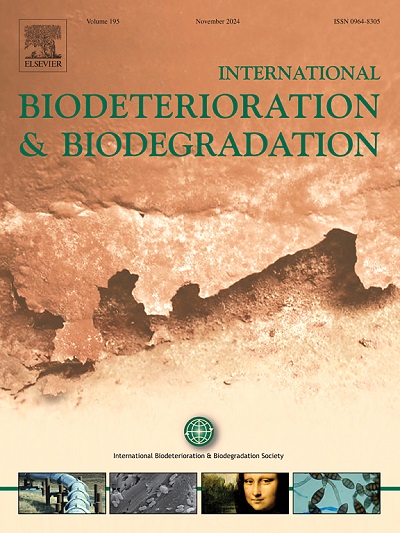Innovative strategy for dechlorination of halogenated organic Pollutants: Microbial-Derived formate production and Immobilized-PdNP biosynthesis
IF 4.1
2区 环境科学与生态学
Q2 BIOTECHNOLOGY & APPLIED MICROBIOLOGY
International Biodeterioration & Biodegradation
Pub Date : 2025-05-23
DOI:10.1016/j.ibiod.2025.106129
引用次数: 0
Abstract
Halogenated organic pollutants (HOPs) are accumulating in the environment, posing significant ecological risks. Microbial-driven palladium nanoparticles (PdNPs) facilitate efficient reductive hydrodehalogenation, offering a promising approach for HOPs remediation. To address the limitations associated with hydrogen donor addition and catalyst detachment, this study proposed a proof-of-concept strategy for developing a novel two-stage dehalogenation reactor. We initially constructed genetically engineered Shewanella oneidensis MR-1 to enhance the production and accumulation of formate as the hydrogen donor. Subsequently, encapsulated PdNPs was biosynthesized within alginate beads for efficient immobilization. Finally, a two-stage reactor was constructed for dechlorination of 2,4,6-trichlorophenol (2,4,6-TCP). In the first-stage reactor, the immobilized engineered strain accumulated 2.04 mM formate, providing sufficient hydrogen donors. In the second-stage reactor, 40 μM 2,4,6-TCP was completely dechlorinated within 10 h. Reactor performance was optimized through pH, lactate concentration, and initial pollutant load. Degradation product analysis revealed that dechlorination of 2,4,6-TCP was occurred via a one-electron transfer reaction, with the chlorinated intermediates being progressively hydrodechlorinated until the final product phenol. Furthermore, this constructed reactor exhibited high dechlorination efficiency for 2,4,6-TCP in real water samples and showed remediation potential for other HOPs. This study provides a promising strategy for the effective management of halogenated wastewater pollution.

卤化有机污染物脱氯的创新策略:微生物衍生甲酸生产和固定化pdnp生物合成
卤化有机污染物(HOPs)在环境中不断积累,构成了重大的生态风险。微生物驱动的钯纳米颗粒(PdNPs)促进了高效的还原加氢脱卤,为啤酒花的修复提供了一种很有前景的方法。为了解决与氢供体加成和催化剂分离相关的局限性,本研究提出了一种开发新型两级脱卤反应器的概念验证策略。我们最初构建了基因工程的希瓦氏菌MR-1,以提高甲酸作为氢供体的生产和积累。随后,包封的PdNPs在海藻酸珠内生物合成,以实现有效的固定化。最后,建立了一个两级反应器,用于2,4,6-三氯苯酚(2,4,6- tcp)的脱氯。在第一级反应器中,固定化工程菌株积累了2.04 mM甲酸,提供了足够的供氢体。在第二级反应器中,40 μM 2,4,6- tcp在10 h内完全脱氯。通过pH、乳酸浓度和初始污染物负荷对反应器性能进行优化。降解产物分析表明,2,4,6- tcp的脱氯是通过单电子转移反应进行的,氯化的中间体逐渐被氢脱氯,直到最终产物苯酚。此外,该反应器在实际水样中对2,4,6- tcp具有较高的脱氯效率,并对其他啤酒花具有修复潜力。本研究为卤化废水污染的有效治理提供了一种有前景的策略。
本文章由计算机程序翻译,如有差异,请以英文原文为准。
求助全文
约1分钟内获得全文
求助全文
来源期刊
CiteScore
9.60
自引率
10.40%
发文量
107
审稿时长
21 days
期刊介绍:
International Biodeterioration and Biodegradation publishes original research papers and reviews on the biological causes of deterioration or degradation.

 求助内容:
求助内容: 应助结果提醒方式:
应助结果提醒方式:


